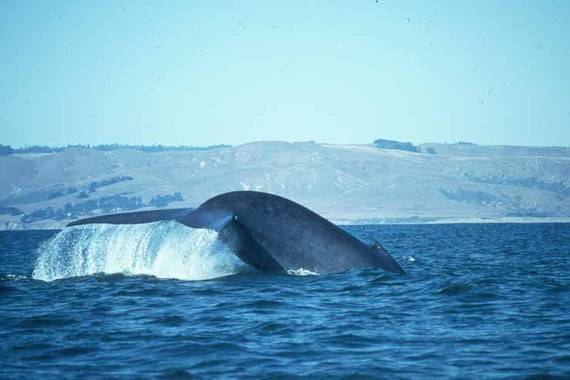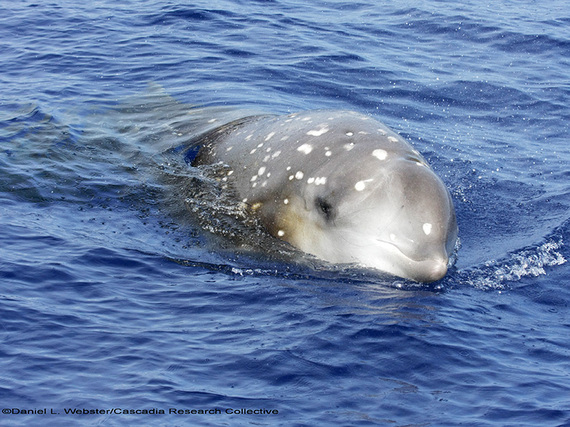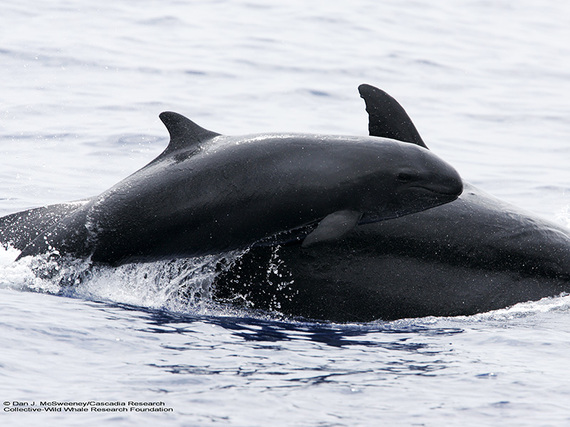Sometimes lasting change takes a lot longer than it should. Consider, for example, the U.S. Navy's testing and training with heavy explosives and high-intensity sonar in species-rich coastal waters around the world.
 Blue whale: A blue whale fluking off Southern California. Blue whales are the largest animal ever to have lived on the planet and are considered endangered. The settlement protects important blue whale foraging grounds off San Diego County, California. (Credit: John Calambokidis/ Cascadia Research.)
Blue whale: A blue whale fluking off Southern California. Blue whales are the largest animal ever to have lived on the planet and are considered endangered. The settlement protects important blue whale foraging grounds off San Diego County, California. (Credit: John Calambokidis/ Cascadia Research.)
Since 1994, the Natural Resources Defense Council (NRDC) has prosecuted a series of federal lawsuits to persuade the Navy to adopt -- and its federal regulator the National Marine Fisheries Service to require -- common sense safeguards for the protection of whales and other marine life from unnecessary and avoidable harm. In none of these cases has a choice been required between training or not, between military readiness or not; in every case the choice presented has been training recklessly - in violation of federal law -- or training in an environmentally responsible way.
With a groundbreaking settlement of two lawsuits this week, there is renewed hope that the Navy's commitment to adopt significant new safeguards on two of its most important training ranges - in waters off southern California and Hawaii - could signal a fundamental shift in its approach toward wildlife conservation in the oceans in which it operates. For the first time, among other measures, the Navy has agreed to forego entirely or limit significantly its planned explosives testing and mid-range sonar training in designated areas of special importance to the survival of majestic blue whales, deep-diving beaked whales, critically endangered false killer whales, and other marine mammals needlessly put at risk by Navy training.

Melon-headed whale: A group of melon-headed whales off Hawaii. Several small populations of melon-headed whales, ordinarily a deep-water species, reside around the Hawaiian Islands. In 2004, about 150-200 whales were trapped in Hanalei Bay during a Navy sonar exercise, and were rescued by locals. The settlement protects their habitat around the Big Island of Hawaii. (Credit: Daniel L. Webster/ Cascadia Research.)
This agreement reflects real progress, with a solid commitment by the Navy to the most meaningful protective measures that NRDC and others, supported by the marine science community, have long sought. It is an important breakthrough in the Navy's relationship to the oceans.
Why now? And what does this portend for the Navy's willingness to adopt similar safeguards in its training elsewhere, in other ranges not covered by the settlement? According to a Navy spokesperson for the Pacific Fleet earlier this week, the Navy agreed to the settlement because it faced "a real possibility that the court would stop critically important testing and training," needed to "prepare for missions in support of our national security."
And, indeed, the Navy had reason to worry:
In a decision issued last spring in the cases settled this week, U.S. District Judge Susan Oki Mollway rejected in no uncertain terms, under a number of environmental laws, the Navy's position. She cited, for example, the Navy's "total failure to clearly consider important information" and "flaws so fundamental that the [environmental planning] document needs to be totally rewritten." Judge Mollway concluded that "the Navy's categorical and sweeping statements, which allow for no compromise at all as to space, time, species, or condition, do not constitute the 'hard look' required" by federal law.

Cuvier's beaked whale: A rare photo of a (Hawaiian) Cuvier's beaked whale, which, at 3000 meters, has recorded the deepest dives ever seen in a marine mammal. Beaked whales are acutely vulnerable to mid-frequency sonar, having repeatedly figured in mass strandings associated with Navy sonar training. The settlement protects beaked whale habitat off Hawaii and in Southern California. (Credit: Daniel L. Webster/ Cascadia Research.)
But faced with such unequivocal language, the Navy chose to negotiate -- rather than elevate the battle to the appellate court - and, in so doing, it displayed an encouraging evolution in the perspective of its leadership. The uncompromising but long held notion that national security requires virtually every square mile of the world's oceans to be available for training with heavy explosives and high-intensity sonar, regardless of the risks to sensitive resources, simply argues too much, whether in a court of law or in the court of public opinion. Central to this week's agreement is a recognition around the table that, consistent with military readiness, geographical or seasonal training exclusions are feasible, and in that recognition lies the promise of lasting progress.
All of us have a critical stake in our national security, and we owe a lasting debt of gratitude to the servicemen and women who secure it. But the mere assertion of a national security interest has never provided a blanket exemption from compliance with federal law. And on issues going far beyond environmental protection, the military has a long and unsuccessful history of resistance on that basis to important changes in deeply entrenched practices.

False killer whale: A false killer whale mother and calf off the main Hawaiian Islands. The settlement protects their habitat around the Big Island, Maui, and Molokai. These whales are listed as endangered, with only 150 remaining. (Credit: Dan McSweeney/ Cascadia Research.)
Outlawing racial discrimination in the military, for example, took decades. Ending discrimination based on sexual preference took just as long. The role of women in combat remains unresolved today, although there is progress on the horizon. In each case, the consistent justification for perpetuating discrimination - in opposing changes that society as a whole has come to accept as morally and strategically responsible -- has been that military effectiveness and readiness would be compromised. The Navy's assertion of that same rationale in opposing common-sense safeguards to protect the oceans is similarly indefensible.
This week's agreement isn't the final word. But it is a promising indication that the Navy can accomplish its core mission in a manner that reduces the unnecessary infliction of harm. Building on this promise, the Navy has the opportunity to demonstrate the leadership of which it is justifiably proud, not just in defending this country but in protecting our oceans.
Lasting change is difficult to achieve, and often it takes too long. But environmental responsibility and military readiness aren't mutually exclusive, and change is coming.
Joel Reynolds is Western Director and Senior Attorney at the Natural Resources Defense Council, based in Los Angeles. He founded NRDC's Marine Mammal Protection Project in 1994.
